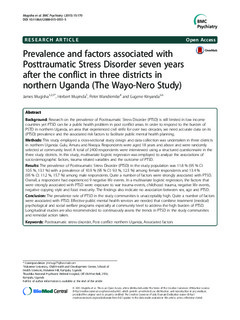| dc.contributor.author | Mugisha, James | |
| dc.contributor.author | Muyinda, Herbert | |
| dc.contributor.author | Wandiembe, Peter | |
| dc.contributor.author | Kinyanda, Eugene | |
| dc.date.accessioned | 2019-11-28T06:54:41Z | |
| dc.date.available | 2019-11-28T06:54:41Z | |
| dc.date.created | 2015-10-08T11:24:34Z | |
| dc.date.issued | 2015 | |
| dc.identifier.citation | BMC Psychiatry. 2015, 15 1-12. | nb_NO |
| dc.identifier.issn | 1471-244X | |
| dc.identifier.uri | http://hdl.handle.net/11250/2630805 | |
| dc.description.abstract | Background
Research on the prevalence of Posttraumatic Stress Disorder (PTSD) is still limited in low income countries yet PTSD can be a public health problem in post conflict areas. In order to respond to the burden of PSTD in northern Uganda, an area that experienced civil strife for over two decades, we need accurate data on its (PTSD) prevalence and the associated risk factors to facilitate public mental health planning.
Methods
This study employed a cross-sectional study design and data collection was undertaken in three districts in northern Uganda: Gulu, Amuru and Nwoya. Respondents were aged 18 years and above and were randomly selected at community level. A total of 2400 respondents were interviewed using a structured questionnaire in the three study districts. In this study, multivariate logistic regression was employed to analyze the associations of socio-demographic factors, trauma related variables and the outcome of PTSD.
Results
The prevalence of Posttraumatic Stress Disorder (PTSD) in the study population was 11.8 % (95 % CI: 10.5 %, 13.1 %) with a prevalence of 10.9 % (95 % CI: 9.3 %, 12.5 %) among female respondents and 13.4 % (95 % CI: 11.2 %, 15.7 %) among male respondents. Quite a number of factors were strongly associated with PTSD. Overall, a respondent had experienced 9 negative life events. In a multivariate logistic regression, the factors that were strongly associated with PTSD were: exposure to war trauma events, childhood trauma, negative life events, negative copying style and food insecurity. The findings also indicate no association between sex, age and PTSD.
Conclusion
The prevalence rate of PTSD in the study communities is unacceptably high. Quite a number of factors were associated with PTSD. Effective public mental health services are needed that combine treatment (medical) psychological and social welfare programs especially at community level to address the high burden of PTSD. Longitudinal studies are also recommended to continuously assess the trends in PTSD in the study communities and remedial action taken. | nb_NO |
| dc.language.iso | eng | nb_NO |
| dc.publisher | BioMed Central | nb_NO |
| dc.rights | Navngivelse 4.0 Internasjonal | * |
| dc.rights.uri | http://creativecommons.org/licenses/by/4.0/deed.no | * |
| dc.title | Prevalence and factors associated with Posttraumatic Stress Disorder seven years after the conflict in three districts in northern Uganda (The Wayo-Nero Study) | nb_NO |
| dc.type | Journal article | nb_NO |
| dc.type | Peer reviewed | nb_NO |
| dc.description.version | publishedVersion | nb_NO |
| dc.source.pagenumber | 1-12 | nb_NO |
| dc.source.volume | 15 | nb_NO |
| dc.source.journal | BMC Psychiatry | nb_NO |
| dc.identifier.doi | 10.1186/s12888-015-0551-5 | |
| dc.identifier.cristin | 1279208 | |
| dc.description.localcode | This article is published under license to BioMed Central Ltd. This is an Open Access article distributed under the terms of the Creative Commons Attribution License (http://creativecommons.org/licenses/by/4.0), which permits unrestricted use, distribution, and reproduction in any medium, provided the original work is properly credited. | nb_NO |
| cristin.unitcode | 194,65,20,0 | |
| cristin.unitname | Institutt for samfunnsmedisin og sykepleie | |
| cristin.ispublished | true | |
| cristin.fulltext | original | |
| cristin.qualitycode | 1 | |

